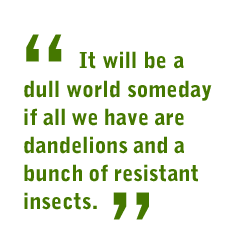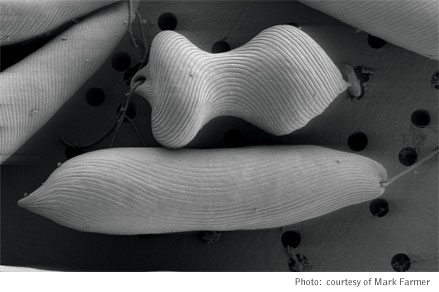


Putting Organisms in Their Places
by Carole VanSickle
Intro/ Ecological Imbalance
| The Value of Little Green Things/ Toward Predicting Function
| Beetlemania/ Knowledge is Strength

![]()
Searching for Diamonds in the Rough

The Value of Little Green Things
Part of that challenge is to distinguish harmless microorganisms from any pathogenic cousins, identify the conditions that unleash the destructiveness, and understand the possible effects on the environment and on humans.
“As the amount of information about organisms continues to grow, it will become imperative for people to know not only what they are working with specifically but also what its ‘friends and relatives’ can do,” said Farmer, who directs the UGA Center for Advanced Ultrastructural Research. Farmer and colleagues at the University of Michigan study euglenoids, tiny one-celled swimmers most commonly recognized by high-school biology students as “the little green things that glide around under a microscope,” he said.
“Euglenoids have a very ancient evolutionary history,” Farmer said. “The more we know about different euglenoids, the more we can learn not only about present-day organisms but also about the ancestor cell that is the origin of life on earth.” His team focuses largely on comparative taxonomy, which involves distinguishing certain physical traits within families of organisms.
Using research derived from the results of his PEET-related work, and collaborating with many other systematists from around the world, Farmer also has developed and published a new classification system to replace the Linnaean system, which uses the traditional groupings of kingdom, phylum, order, family, genus and species. Farmer’s system (see sidebar p. 11) groups all living things around a central ancestor so that different groupings of organisms resemble the petals on a flower. The farther apart the petals, the more divergent are the species within the groups.
“Knowing how organisms differ from each other can be very important for the development of medicinal treatments,” Farmer said. “When groups have totally different evolutionary histories, you may be able to find unique molecular targets that can lead to medicines that will impact an organism without hurting its host.”
Take, for example, Chagas disease and African sleeping sickness, which combined affect more than 18 million people a year. A single epidemic can infect 50,000 people or more at a time and often result in nearly that many fatalities, according to the National Institutes of Health. These cardiac and neural infections are caused by an organism closely related to euglenoids and very distantly related to humans, so conditions and treatments that affect Farmer’s organisms indicate possible medical approaches to these deadly parasites.

Euglenoids (at top and electron micrograph above), those one-celled organisms commonly studied in high-school biology, hold clues to the evolutionary history of life on earth. They also may shed light on the development of medical approaches to African sleeping sickness and other disease-causing organisms that are closely related to harmless euglenoids.
Towards Predicting Function
As the amount of new information about organisms’ genetic workings increases, institutions such as the Joint Genome Institute (JGI), a U.S. Department of Energy coalition managed by the University of California, are discovering how the organization of an organism’s genes and proteins relates to its structure and function.
“Taxonomy’s value has increased as high-volume DNA sequencing clarifies and expedites the identification process,” said Ari Patrinos, associate director for biological and environmental research at the DOE, whose office supports and funds JGI.
High-volume sequencing also permits scientists to sequence vast amounts of DNA from undocumented origins — a practice known as “prospecting” [see sidebar p. 13].
“Gene prospectors” look for signature sequences that are unique to groups of organisms with a common ancestry. Once they have identified these sequences, a taxonomist can use the information to help place newly discovered organisms in the right groups. Also, the volume of sequences in a sample can indicate what an organism’s role is in a particular environment.
“If you isolate gene sequences from 100 organisms and 95 percent of them are from Dr. Porter’s chytrids, then you know that chytrids are major players in that environment even if you don’t know exactly which ones they are yet,” Farmer said. “It helps you know where to look and what to look for.”
Such research is not limited to analyzing pathogenicity, but it also can contribute to positive new applications. “As investigations by JGI are shedding light on the cellular machinery of microbes,” Patrinos said, “they may be harnessed to clean up contaminated soil or water, capture carbon from the atmosphere and produce potentially important sources of energy.”
Intro/ Ecological Imbalance
| The Value of Little Green Things/ Toward Predicting Function
| Beetlemania/ Knowledge is Strength
For comments or for information please e-mail: rcomm@uga.edu
To contact the webmaster please email: ovprweb@uga.edu
![]()